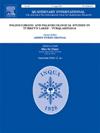Environmental changes and historical occupation at Oued Laksar (Ksar Seghir), Morocco
IF 1.9
3区 地球科学
Q3 GEOGRAPHY, PHYSICAL
引用次数: 0
Abstract
Laksar is a small river near the village of Ksar Seghir, located between Tangier and Ceuta (Morocco), strategic points to control the Strait of Gibraltar over centuries. The river outlets at the western part of a sandy beach that can block the fluvial discharge in years of low precipitation/river flow.
The area is densely occupied since the 5th century BC, during the roman period and Early Middle Age in the archaeological site of Dhar d’Aseqfane, located around 1 km from the mouth of the river. The coastal town of Ksar Seghir was founded on the eastern margin and was used as a shipyard for Moroccan dynasties after the 12th century. During the 15th and 16th centuries, Portugal occupied Ksar Seghir to control the Strait and to increase its power in North Africa. After the Portuguese left the site remained abandoned. The present-day Moroccan village developed in the 20th century, first expanding on the western river slope and gradually encompassing the archaeological site.
This work aims to i) characterize the environmental evolution of the Laksar River; ii) identify potential records of extreme events such as floods or tsunamis; and iii) explore the relationship between the landscape dynamics and human occupation.
To achieve these goals, a ∼5.4 m long sediment core - KS1 - was studied applying high-resolution multiproxy analyses (X-Ray, magnetic susceptibility, sedimentology, organic chemistry and micropalaeontology) together with 14C dating to establish a chronological model.
The sedimentary sequence corresponds to intercalations of fine sand and mud. Results point to deposition in subtidal conditions between the core base (ca. 2500 cal BP) and the 15th century AD (388 cm below surface). The dominance of marine foraminifera assemblages with high number of juveniles and high diversity index suggests an environment under open marine conditions during this period. Conversely, the low δ13C values, coupled with the presence of charophytes and Cretaceous, Paleogene and Neogene reworked calcareous nannofossils reflect the contribution of fluvial processes. The sedimentary record underscores fluctuations in fluvial discharge, beach morphology and marine influence. The accumulation of magnetic (heavy) minerals at the core base is the likely result of at least one high-energy event.
Following the onset of Portuguese occupation of Ksar Seghir (15th century), the sedimentation rate increases, silting-up the channel margins. Deposition occurs under low subtidal to intertidal conditions. Foraminifera assemblages point to a low salinity environment; coarse materials are mostly constituted by minerogenic particles transported by the fluvial network. Changes in the sedimentary succession (heavy-minerals accumulation, higher marine influence and rip-up clasts) were detected between 219 cm and 140 cm depth below surface that, according to the age-model, overlap temporally with the Lisbon 1755 AD tsunami event (Great Lisbon earthquake).
摩洛哥Oued Laksar (Ksar Seghir)的环境变化和历史占领
Laksar是Ksar Seghir村附近的一条小河,位于丹吉尔和休达(摩洛哥)之间,几个世纪以来一直是控制直布罗陀海峡的战略要地。在降水少/流量少的年份,河流的出口位于沙滩的西部,可以阻挡河流的排出。自公元前5世纪罗马时期和中世纪早期以来,该地区就被密集占领,位于距离河口约1公里的Dhar d 'Aseqfane考古遗址。沿海城镇Ksar Seghir建立在东部边缘,12世纪后被用作摩洛哥王朝的造船厂。在15世纪和16世纪,葡萄牙占领了Ksar Seghir,以控制海峡并增加其在北非的权力。葡萄牙人离开后,这个遗址被遗弃了。今天的摩洛哥村庄在20世纪发展起来,首先扩展到西部河坡,逐渐包围了考古遗址。本研究的目的是:1)描述拉克萨河的环境演变;Ii)识别洪水或海啸等极端事件的潜在记录;iii)探索景观动态与人类活动的关系。为了实现这些目标,研究人员使用高分辨率多代理分析(x射线、磁化率、沉积学、有机化学和微古生物学)和14C定年法研究了一个约5.4 m长的沉积物岩心KS1,以建立一个年代模型。沉积层序对应于细砂泥夹层。结果表明,沉积在岩心基底(约2500 cal BP)和公元15世纪(地表以下388 cm)之间的潮下条件下。这一时期的海洋有孔虫群落以幼虫数量多、多样性指数高的海洋有孔虫群落为主,表明其处于开放的海洋环境。相反,低δ13C值,加上船形植物和白垩系、古近系和新近系改造的钙质纳米化石的存在,反映了河流作用的贡献。沉积记录强调了河流流量、海滩形态和海洋影响的波动。磁性(重)矿物在地核底部的积累很可能是至少一次高能事件的结果。葡萄牙人占领Ksar Seghir(15世纪)后,沉积速率增加,淤积了海峡边缘。沉积发生在低潮下至潮间带条件下。有孔虫组合指向低盐度环境;粗粒物质主要由河流网络输送的成矿颗粒构成。在地表以下219厘米至140厘米深度之间发现了沉积演替的变化(重矿物积聚、较高的海洋影响和破碎),根据年龄模型,这些变化与公元1755年里斯本海啸事件(里斯本大地震)在时间上重叠。
本文章由计算机程序翻译,如有差异,请以英文原文为准。
求助全文
约1分钟内获得全文
求助全文
来源期刊

Quaternary International
地学-地球科学综合
CiteScore
5.60
自引率
4.50%
发文量
336
审稿时长
3 months
期刊介绍:
Quaternary International is the official journal of the International Union for Quaternary Research. The objectives are to publish a high quality scientific journal under the auspices of the premier Quaternary association that reflects the interdisciplinary nature of INQUA and records recent advances in Quaternary science that appeal to a wide audience.
This series will encompass all the full spectrum of the physical and natural sciences that are commonly employed in solving Quaternary problems. The policy is to publish peer refereed collected research papers from symposia, workshops and meetings sponsored by INQUA. In addition, other organizations may request publication of their collected works pertaining to the Quaternary.
 求助内容:
求助内容: 应助结果提醒方式:
应助结果提醒方式:


